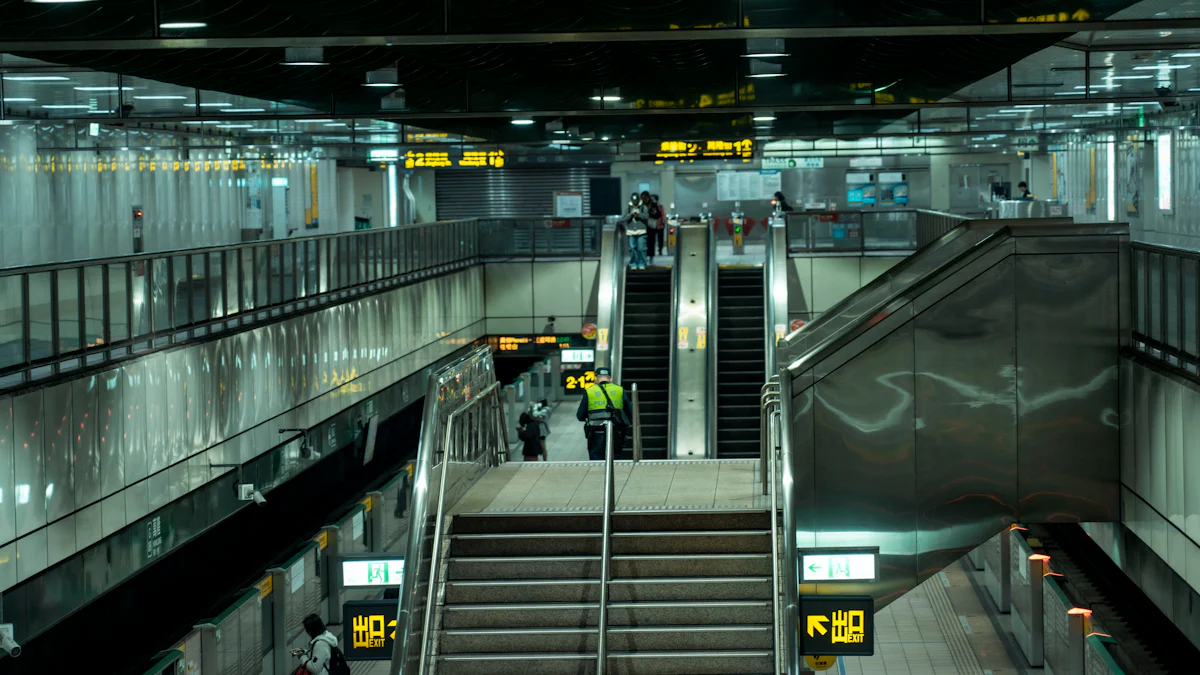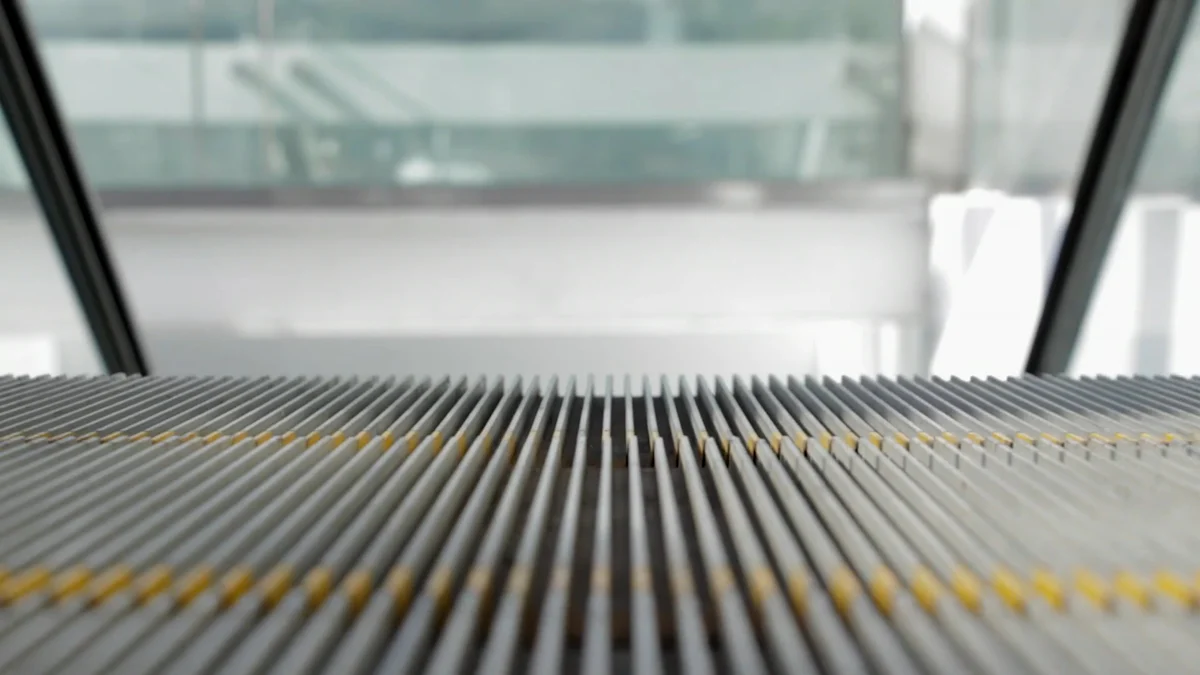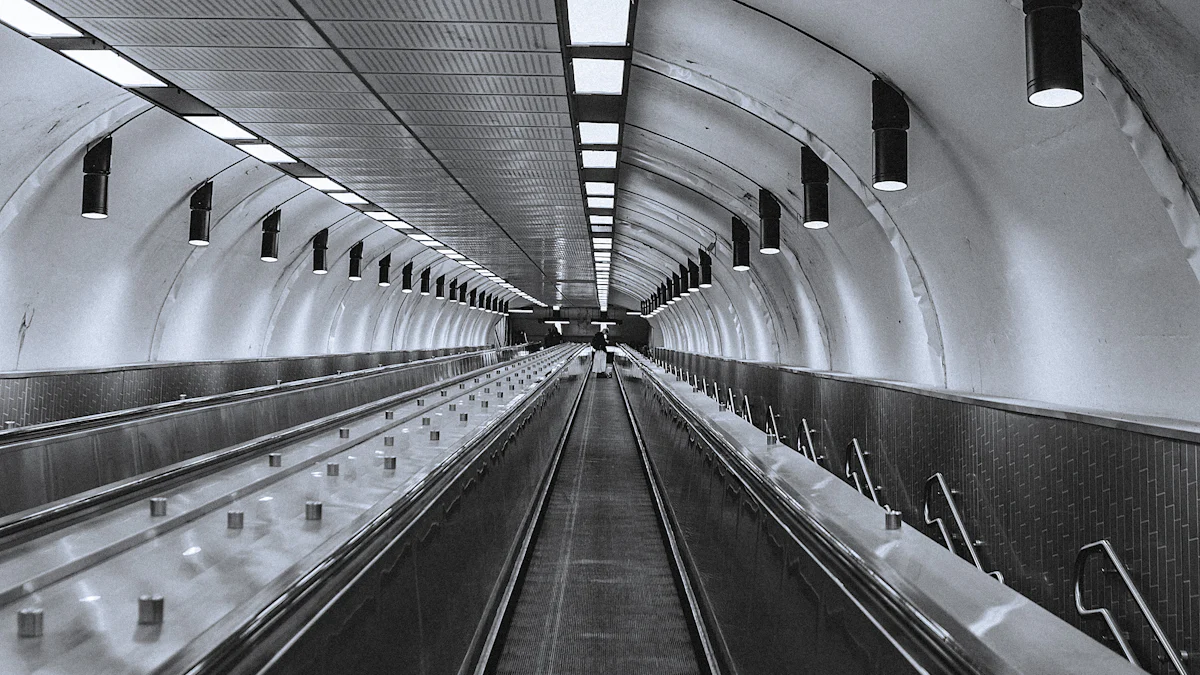Differences Between Escalators and Moving Walkways Explained

Have you ever thought about the differences between an escalator and a moving walkway? Understanding 自动扶梯和自动人行道的区别 comes down to their design and purpose. An escalator is designed to help you move vertically, such as between floors, while a moving walkway is ideal for horizontal or slightly inclined travel. These distinctions play a significant role in how they are used in everyday life.
Key Takeaways
- Escalators move people up or down between floors in buildings.
- Moving walkways help people travel straight across long distances fast.
- Both need regular care to stay safe and work well.
What Are Escalators?

Definition and Purpose
Escalators are moving staircases that help you travel between different levels in a building. They’re designed to make vertical movement easier and faster, especially in places where stairs might feel like too much effort. You’ve probably seen them in malls, airports, or subway stations. Unlike elevators, which carry you in a closed space, escalators let you step on and ride up or down in an open, continuous flow. They’re perfect for handling large groups of people efficiently.
Key Features
Escalators have some unique features that make them stand out. First, they’re built with a series of linked steps that move in a loop. These steps stay level as they carry you up or down. Handrails on both sides move at the same speed as the steps, giving you something to hold onto for balance. Most escalators also have safety features like emergency stop buttons and anti-slip surfaces. Some even adjust their speed based on how many people are using them. This combination of design and technology ensures a smooth and safe ride.
Common Uses
You’ll find escalators in places where moving large numbers of people quickly is essential. Shopping malls use them to connect floors and make it easier for you to explore stores. Airports rely on them to help passengers navigate terminals. Subway and train stations use escalators to manage the flow of commuters. They’re also common in office buildings, stadiums, and convention centers. Escalators are all about convenience and efficiency, especially in high-traffic areas.
What Are Moving Walkways?

Definition and Purpose
Moving walkways, also called travelators or moving sidewalks, are flat conveyor belts designed to help you move across horizontal or slightly inclined surfaces. They’re like escalators but without the steps. You simply step onto the walkway, and it carries you forward. These walkways are perfect for reducing the effort of walking long distances, especially when you’re in a hurry or carrying heavy luggage. You’ll often see them in places like airports or large transit hubs where getting from one point to another can take a lot of time.
Key Features
Moving walkways have some interesting features that make them stand out. The surface is flat and usually made of metal or rubber, providing a smooth ride. Handrails run along both sides, giving you extra stability if needed. Some walkways are straight, while others have a slight incline to help you move up or down small slopes. Many modern walkways also have sensors that adjust their speed based on how many people are using them. This ensures efficiency and safety. Unlike escalators, moving walkways are designed for continuous horizontal movement, making them ideal for large, open spaces.
Common Uses
You’ll find moving walkways in places where walking long distances is common. Airports are the most popular example. They help you get to your gate faster, especially when you’re running late. Large shopping centers and amusement parks also use them to make it easier for you to navigate sprawling areas. Some cities even install them in busy pedestrian zones or subway stations to improve foot traffic flow. Moving walkways are all about convenience and saving time, especially in high-traffic environments.
自动扶梯和自动人行道的区别 in Design and Functionality
Structural Differences
When you look at an escalator, you’ll notice it’s built like a staircase. The steps are linked together in a loop, creating a continuous flow that moves up or down. On the other hand, moving walkways are flat or slightly inclined. They resemble conveyor belts more than stairs. This difference in structure is what makes escalators perfect for vertical movement and moving walkways ideal for horizontal travel. Escalators also require more vertical space because of their incline, while moving walkways can stretch across long, flat areas without taking up much height.
Movement and Mechanics
The way these two systems move is another key part of 自动扶梯和自动人行道的区别. Escalators use a chain-driven system to move their steps in a synchronized loop. Each step stays level as it moves, ensuring a smooth ride. Moving walkways, however, use a flat conveyor belt mechanism. Some even have rollers underneath to reduce friction. This design allows them to handle long distances without the need for steps. Both systems rely on electric motors, but their mechanics are tailored to their specific purposes.
Speed and Capacity
Escalators typically move at a speed of about 0.5 meters per second. This is fast enough to keep people moving efficiently without feeling rushed. Moving walkways, however, can vary in speed. Some are slower, while others can reach up to 0.75 meters per second, especially in airports where speed matters. In terms of capacity, escalators can handle a steady flow of people, but moving walkways often accommodate larger crowds over longer distances. This makes them ideal for places like transit hubs.
Efficiency and Space Utilization
Installation Space Requirements
When it comes to installation, escalators and moving walkways have different space needs. Escalators require a significant amount of vertical space due to their incline. You’ll often see them in buildings with high ceilings or multi-level layouts. Moving walkways, on the other hand, are more flexible. They stretch across long, flat areas and don’t need much height. This makes them perfect for sprawling spaces like airports or large shopping centers. If you’re planning a project, think about the available space and how people will move through it.
Energy Efficiency
Energy use is another factor to consider. Escalators consume more energy because they lift people vertically. The motors work harder to overcome gravity. Moving walkways, however, are more energy-efficient. They only need to move people horizontally or on slight inclines. Some modern systems even adjust their speed based on foot traffic, saving energy when fewer people are using them. If you’re looking for a greener option, moving walkways might be the better choice.
High-Traffic Suitability
Both systems handle high traffic well, but they shine in different ways. Escalators are great for moving people between floors quickly. They’re ideal for places like subway stations or malls. Moving walkways excel in areas where people need to cover long distances. Airports use them to help passengers get to their gates faster. Understanding 自动扶梯和自动人行道的区别 can help you decide which one fits your needs better.
Safety and User Experience
Safety Features of Escalators
Escalators come with several safety features to keep you secure while riding. One of the most noticeable is the emergency stop button. If something goes wrong, you can press it to stop the escalator immediately. The steps also have anti-slip surfaces to prevent you from slipping. Skirt brushes along the sides help keep loose items like shoelaces or clothing from getting caught. Some escalators even have sensors that detect obstructions and stop the system automatically. These features work together to make your ride as safe as possible.
Tip: Always stand in the center of the step and hold the handrail for extra stability.
Safety Features of Moving Walkways
Moving walkways are designed with safety in mind too. Like escalators, they have emergency stop buttons that you can use in case of an issue. The flat surface often includes textured patterns to reduce the risk of slipping. Handrails on both sides provide support, especially when the walkway is inclined. Some walkways also have warning lights or sounds to alert you when you’re approaching the end. These features ensure a smooth and secure experience, even in busy areas.
Note: Avoid standing too close to the edges to prevent accidents.
Accessibility and Ease of Use
Both escalators and moving walkways are built to be user-friendly. Escalators are great for people who need help moving between floors without climbing stairs. Moving walkways, on the other hand, make long distances feel shorter. They’re especially helpful if you’re carrying luggage or feeling tired. Both systems are accessible to most people, including those with mobility challenges. However, elevators might be a better option for wheelchairs or strollers. Understanding 自动扶梯和自动人行道的区别 can help you choose the right option for your needs.
Maintenance and Durability
Maintenance Needs
Both escalators and moving walkways need regular maintenance to stay in top shape. You might not think about it, but these systems work hard every day. Escalators require frequent inspections to check the steps, handrails, and chain mechanisms. Technicians often clean and lubricate the moving parts to prevent wear and tear. Moving walkways, on the other hand, need attention to their conveyor belts and rollers. Dirt and debris can build up over time, so cleaning is essential. Regular maintenance not only keeps them running smoothly but also ensures safety for everyone using them.
Tip: If you’re managing a facility, schedule routine maintenance checks to avoid unexpected breakdowns.
Durability and Longevity
When it comes to durability, both systems are built to last. Escalators can handle years of heavy use, especially in high-traffic areas like malls or subway stations. Their sturdy construction and robust materials make them reliable. Moving walkways are just as durable, especially when installed in controlled environments like airports. However, their longevity depends on proper care. Neglecting maintenance can shorten their lifespan. With regular upkeep, both systems can serve you for decades without major issues.
Cost of Upkeep
The cost of maintaining these systems can vary. Escalators tend to be more expensive to maintain because of their complex mechanics. You’ll need to budget for parts like chains, steps, and motors. Moving walkways are generally less costly since their design is simpler. However, the length of the walkway can impact maintenance costs. Longer systems may require more frequent servicing. Investing in preventive maintenance can save you money in the long run by avoiding costly repairs.
Note: Always factor in maintenance costs when planning to install escalators or moving walkways. It’s a smart way to protect your investment.
Escalators and moving walkways serve different purposes. Escalators shine in vertical spaces, while walkways simplify horizontal travel. Your choice depends on space, efficiency, and safety needs. Regular maintenance keeps them safe and reliable.
Remember: Whether you’re designing a mall or an airport, understanding these systems ensures the best fit for your space.
FAQ
1. Can you walk on a moving walkway or escalator?
Yes, you can! Walking on both is allowed, but always stay aware of others. Stand on the right if you’re not walking.
2. Which is safer: escalators or moving walkways?
Both are safe when used correctly. Escalators have more safety features, but walkways are easier for those with mobility challenges.
3. Do escalators and moving walkways use a lot of energy?
Not always. Modern systems adjust speed based on usage, making them energy-efficient when traffic is low.